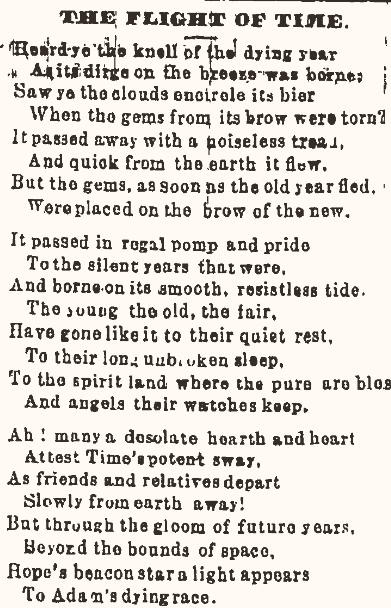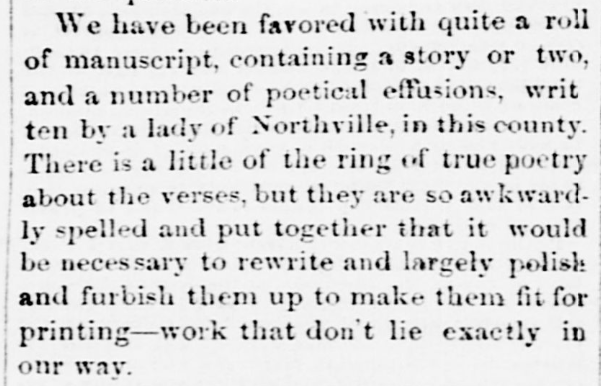Poetry and Serials
- Home
- Community in the Columns
- Special Exhibitions
- Poetry and Serials

The first edition of 1863, the year of Gettysburg, the Wayne County Democrat ran a bleak poem for the new year on its front page. “The Flight of Time” begins by asking the reader if they have heard “the knell of the dying year” and ends gloomily by describing humanity as “Adam’s dying race.”1 The poem is full of death and despair and reflects the mood of Wayne County on the brink of the bloodiest year in the Civil War.
Poetry and serials (short stories published, usually in installments) tell us a lot about the mood, values, and beliefs of the Wooster and Wayne County community. During the war, the Wayne County Democrat was liable to publish scathing poetry criticizing Abraham Lincoln.2 Poems published in the years after the war focus on God leading the way out of the dark of the past.3 As the country approached Civil War, toppled into carnage, and then slowly clawed its way back out again, the front-page poems gave direct insight to how the community was reacting to about the world around them. Serials served a similar purpose. In the newspaper announcing the election of Lincoln, the first page was reserved for a poem titled A Country Cottage and two serials, titled Adventure of an Orphan Boy: A Tale of Adventure and Politics and Burning of the Willows: A Tale of the Revolution.4 On the brink of Civil War, Wayne County was already thinking about politics and revolution.

One of the key distinctions between nineteenth century newspapers and modern publications is the prominence of poetry. Printed books were expensive, so newspapers were the most accessible form of literature for most Wayne County citizens. As a result, serials and poetry were in high demand as entertainment. Poetry was featured on the front page of almost every edition of the Wayne County Democrat and The Wooster Republican, taking visual priority over matters of local, state, and national news. The prominence of poems and serials not only demonstrates what the community was interested in, but also what the Wooster community found entertaining.
The poets appear to be a mix of men and women, with some poets returning for repeat performances and some poets publishing once, and then never being heard from again. These poets seem to have been predominantly local authors – and our greatest clue for this shows up in an Illinois newspaper, the Ottawa Free Trader. Tucked away on the third page on the issue of April 14, 1860, the editors noted that “we have been favored with quite a roll of manuscript… written by a lady of Northville, in this county. There is little of the ring of true poetry about the verses, but they are so awkwardly spelled and put together that it would be necessary to rewrite them…to make them fit for printing.”5 This note indicated that citizens were in the practice of submitting poetry to their county newspapers in the nineteenth century. This, paired with finding any other records of the published poetry, support the idea that the poets of Wayne County newspapers were largely local writers.

Front page poetry and serials provide valuable insight to the values and interests of the Wooster community. From ominous poems about death on New Year’s Day to serials about revolution, these short snatches of literature published by local writers help us understand the day-to-day attitudes of Wayne County citizens in the nineteenth century.
Footnotes:
1: ”The Flight of Time,” Wayne County Democrat, January 8, 1863, 1.
2: “Three Hundred Dollars More,” Wayne County Democrat, October 22, 1863, 3.
3: “Song By Night,” Wayne County Democrat, March 2, 1870, 1.
4: Wayne County Democrat, November 8, 1860, 1.
5: Ottawa Free Trader, April 14, 1860, 3.

